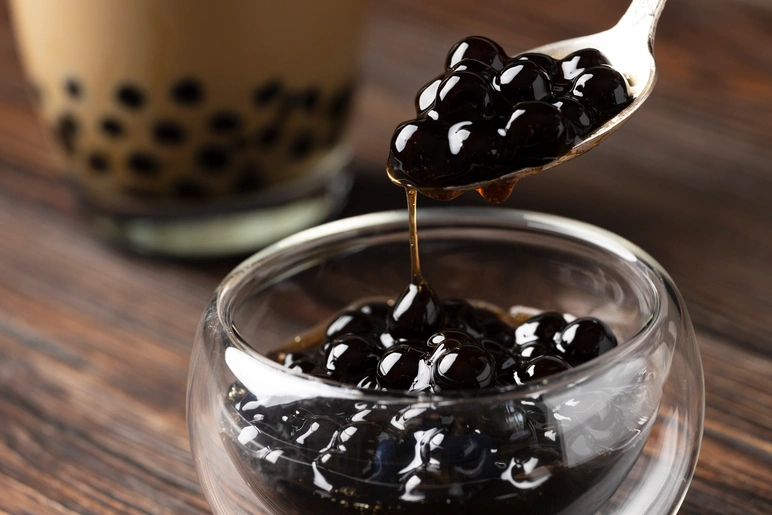Who would've pictured Taiwanese cuisine apart from xiao long bao or the unmistakable aroma of stinky tofu?
A few drinks have quite captured the world's imagination. One of them is bubble tea. Affectionately also known as boba or pearl milk tea, this playful, chewy concoction has transcended its humble origins to become a global delight—and a true symbol of Taiwanese innovation. Served cold, shaken, and crowned with tapioca pearls, bubble tea is as much about texture as it is about taste: one sip delivers a silky tea, a touch of sweetness, and the satisfying pop of pearls.
Bubble tea’s journey from local curiosity to international obsession reflects more than just taste—it represents Taiwan’s creativity, adaptability, and love of joyful experiences. It’s a ritual; it’s the oversized straw, the first pop of pearls, the midday pick-me-up shared with friends.
Bubble tea is a taste of modern Taiwanese identity itself.
Every sip is a reminder of the island’s culinary ingenuity, a playful celebration of texture, and a sweet invitation to discover a drink that has charmed taste buds around the globe.
The birth of bubble tea
Bubble tea may be a global obsession now, while many associate the drink with fun, youthful energy. Its origins, nonetheless, are steeped in creativity and culture. Its story begins in the energetic streets of Taiwan’s late-1980s era of cultural reinvention—a moment when the island was charging toward modernity, and its tea shops were quietly rewriting the rules of what a drink could be.
Though the exact inventor is still debated, Chun Shui Tang in Taichung and Hanlin Tea Room in Tainan both claim to have added the first tapioca pearls to iced tea, transforming a simple beverage into a chewy, sweet sensation. The former experimented sweetened tapioca pearls dropped into iced milk tea looking to surprise customers. Whereas the latter created the first bubble tea during a meeting, tossing tapioca into a drink on a whim. Even decades later, Taiwan courts ruled that no single person owns the drink, a fitting reflection of its collaborative, inventive spirit.
Today, bubble tea is as much a lifestyle accessory as it is a drink—iced, shaken, photographed, and adored. From minimalist boutiques in Taipei to tech-driven tea labs in London and LA, boba has evolved into a globe-spanning favourite with a cult following.
The largest bubble tea ever created measured 680 litres, crafted in Taipei in 2018. There was even the Boba Olympics, with competitions over the fastest pearl cookers and wildest flavour innovation.
The base of bubble tea
Over the years, bubble tea has evolved far beyond its black-tea-and-milk roots. Taiwan’s tea artisans began experimenting with oolong, green tea, and fruit-infused blends, pairing them with rich milk or non-dairy alternatives. Today, the drink ranges from subtle, floral oolong milk teas to fruit teas with popping boba, aloe cubes, or even cheese foam (a sweet, slightly salty twist that exemplifies Taiwan’s boundary-pushing approach to flavour).
Creating bubble tea is a craft; part technique, part theatre:
- Brew bold tea that won’t disappear beneath ice or milk.
- Boil the tapioca pearls, then soak them in caramel-like brown sugar syrup.
- Shake the tea, milk, and sweetener with ice until frothy.
- Assemble: pearls first, tea second.
- Sip through a wide straw.
Taipei, in particular, has become a hotspot for premium, artisanal bubble tea. Shops such as Guiji, John Tea Company, and Jiate emphasize high-quality ingredients: single-origin teas, delicately cooked pearls, and carefully balanced flavours. These contemporary takes highlight the artistry behind bubble tea, showing that it can be both playful and refined, Instagram-ready yet rooted in centuries of Taiwanese tea culture.
More about the pearls

At the heart of bubble tea are the pearls themselves. Tu Tsong, credited with supposedly inventing bubble tea, called the tapioca balls “pearls” because they reminded him of his mother’s necklace.
Ever wondered what those black pearls as one, two, three of them stream to your oversized straw? Tapioca balls are crafted from cassava starch simmered until perfectly soft and bathed in brown sugar syrup until glossy and fragrant. Traditional recipes rely on short shelf lives, but commercial producers sometimes add stabilizers to ensure longevity. Regardless of method, the pearls remain the star of the show, their texture defining the drink’s signature chew and tactile charm.
Although the “bubble” is assumed to be the pearls, it originally described the frothy layer that forms when tea is shaken with ice.
Bubble tea has become a global power player
Bubble tea has transcended culture and geography, crossing across Asia’s megacities as well as the streets of London, New York, and beyond. This sweet icon followed the Taiwanese diaspora to North America and Australia in the 1990s, thriving first in Chinatowns and university neighbourhoods. Social media did the rest.
Taipei, in particular, has become a hotspot for premium, artisanal bubble tea. Shops such as Guiji, John Tea Company, and Jiate emphasise high-quality ingredients: single-origin teas, delicately cooked pearls, and carefully balanced flavours. These contemporary takes highlight the artistry behind bubble tea, showing that it can be both playful and refined, Instagram-ready yet rooted in centuries of Taiwanese tea culture.
It's surprisingly home-friendly too! With the right tea leaves, quality pearls, and a good shaker, homemade bubble tea can feel like crafting your own boutique beverage.
There’s a version for every mood
Iced, hot, blended, subtly sweet or decadently bold—bubble tea’s versatility is part of its appeal. The classic version is made with milk for that velvety, luxe texture that softens and elevates the tea’s bite.
The classic flavours include:
- Fruit Milk Tea
- Green Milk Tea
- Milk Tea
- Taro Milk Tea
Meanwhile, the creative hits are:
- Brown Sugar Boba Milk
- Cheese Tea
- Matcha Boba
Either way, bubble tea is a drink that shapeshifts with your day, your outfit, your mood. For something brighter and fashionably fresh, fruit-based bubble teas, such as mango and lychee, are the epitome of a juicy, modern take. Innovation never slows in Taiwan: sweet potato boba, peanut butter foam, even chili chocolate. If you see a wild flavour, consider it a dare!
Toppings have become a statement as well. Pearls are classic, but the modern bubble tea menu reads like a trend forecast: jelly, silky egg pudding, fresh fruit, aloe vera, matcha foams, and coffee powders. Each cup is customisable!

Where to drink bubble tea in Taiwan
To understand boba, you have to drink it in Taiwan. Ordering is a personal ritual—tea strength, sweetness level, ice amount, and toppings all fine-tuned to your taste. Everyone has “their” order. Some collect limited-edition cups; others chase limited-release flavours for the perfect night-market selfie.
For a true pilgrimage, don’t miss:
- 50 Lan: Taiwan’s go-to chain for consistency and variety.
- Chen San Ding (Gongguan): Beloved by students for its iconic brown sugar pearls.
- Chun Shui Tang (Taichung): Elegant, classic, the birthplace of boba.
- Sharetea: A global favourite still deeply rooted in Taiwan.
- Tiger Sugar (Taipei): Insta-famous for its “tiger stripe” brown sugar.
- Xing Fu Tang: handmade boba and torched brown sugar magic.
And honestly? Any night market stall. Sometimes the most unforgettable boba comes from a tiny cart with a line of loyal locals.



 Mirella Pandjaitan
Mirella Pandjaitan
 Nov 21, 2025
Nov 21, 2025